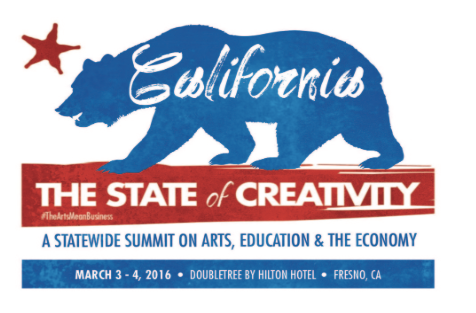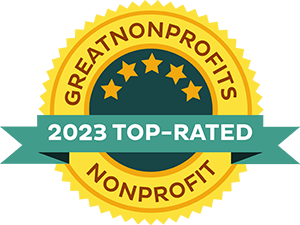By Communications Associate Jacob Campbell

Earlier this month, I had the privilege of attending California: The State of Creativity, a statewide summit on arts, education, and the economy. The convening touted the hashtag #TheArtsMeanBusiness, and the speakers and session leaders stayed true to this motto by diving right into the nitty-gritty issues facing our field. Together, a cross-section of stakeholders including school district administrators, nonprofit service providers, corporate partners, classroom teachers, teaching artists, and parents worked to define (and leverage) a growing movement that California State Superintendent of Public Instruction Tom Torlakson coined the “arts education renaissance.”
“Our big goal is that every child in our schools has a quality K-12 arts education.” — Tom Torlakson, CA State Superintendent of Public Instruction [TWEET]
What does the next era of arts (education) advocacy look like? How do we ignite a data-driven, business-minded, and equity-oriented creative revolution in our schools?
Making the Data-Driven Case for Arts Education
“Data is the new kale!” — Jason Spencer, Principal Advisor to the State Superintendent of Public Instruction [TWEET]
Day one’s opening remarks from Bob Morrison of Quadrant Arts Education Research and Jason Spencer of the California Department of Education underscored the necessity of high-quality data to create change in arts education policy. I think it’s fair to say that, as a field, we strive for access to (and participation in) arts education for every child in every school, but Morrison pointed out that there is no way to know if/when we’ve achieved this goal if we don’t start counting. How can we measure a change over time without a baseline metric?
“Arts education is not exempt from today’s data revolution.” — Bob Morrison, Founder of Quadrant Arts Education Research [TWEET]
Lucky for us, the National Arts Ed Data Project (NAEDP), which is scheduled for release by Fall 2016, should give us a better idea of in-school arts access in four pilot states, including California. A compilation of NCLB-era student information, NAEDP utilizes a consistent set of data points including, but not limited to, course offerings, student enrollment, and grade level to make broad state-to-state comparisons and analyze individual districts and schools on a granular level. This interactive database will visually illustrate levels of arts education access across the state — not to pass judgement, but to highlight the greatest areas of need.

This resource will be very similar to LAUSD’s Arts Equity Index (AIE), and — as with the AIE — it’s important to note what services will not be reflected, specifically the myriad contributions of community arts partners and providers. California’s data set will only reflect grades 6-12 due to more codified courses and teacher requirements (though our state’s lack of Dance and Theater credentials is a bit of a gray area); however, of the data available, users will be able to drill-down to specific schools, grade levels, and even buildings. While it may not (yet!) show us the full picture, the NAEDP will open new conversations around arts access in our schools, and community arts partners should be at-the-ready to develop and implement reporting practices that might better reflect their (robust) role in the arts education ecosystem.
The Business of Arts Education: Strategic Partnerships in the Creative Economy
“The ballerinas in our schools today will be the CEOs of tomorrow.” — Jim Yovino, Fresno County Superintendent of Schools [TWEET]
A new paradigm for the arts, so often marginalized as anything but pragmatic, seems to be emerging. Where once the “starving artist” trope saturated public consciousness, we now have innovative makers and creative entrepreneurs. In addition to the benefits of a well-rounded education that includes the arts, the conversation has become about how to give our students a competitive (and creative) edge in 21st Century careers. We know from the recently released Otis Report on the Creative Economy (LA Region) that LA County’s creative industries account for one in six jobs and 13% of output — that’s $109B! Additionally, emerging results from a California State University San Marcos (CSUSM) led study found that 68% of employees in a STEM-related position at ViaSat reported (to varying degrees) that the arts were integral to success in their current job. Dr Merryl Goldberg (CSUSM) fears that current college students who’ve gone through the NCLB-era public school system largely devoid of arts education won’t be able to compete in a creative workforce that values critical and divergent thinking skills; public and private entities tasked with remedying this opportunity gap have had to explore creative solutions to address students’ needs sustainably.
“We need to position ourselves as solution partners.” — Patricia Wayne, Program Director of createCA [TWEET]
Chula Vista Elementary School District (CVESD) and Avenal Elementary School were among many examples of successful public private partnerships (PPPs) that are reimagining the provision of in-school arts education programs with an eye towards long-term impact. Eric Brown from Turnaround Arts: California discussed increased community engagement and access to arts integration coaching at Avenal Elementary School where P.S. ARTS provides a full-time Teaching Artist with funding from the Wonderful Company. At the recent Arts Education Learning Exchange, CVESD discussed their model for systemic collaboration between school districts and arts education nonprofits. In both cases, community arts organizations and philanthropic/corporate partners increased public buy-in around the efficacy of arts-based learning in increasing student outcomes, and Districts followed suit by allocating State and Federal resources toward the continued success and delivery of arts education programs.

Equity in the Arts: Creativity is a Right, Not a Privilege
“There is systematic relationship between inequality of income & opportunity.” — Economist Dr. Joseph E. Stiglitz on the Creative Economy [TWEET]
Another key theme of this convening was honing our advocacy skills to undo the common misconception that Title I funding can’t or shouldn’t be used for arts-based programs. The California Alliance for Arts Education (in partnership with Arts for LA and LA County Arts Commission – Arts for All) has a host of key resources for making the arts a priority in LCFF goals & LCAPs.
“In an ideal world, good policy is informed by and supports good practice.” — Laura Smyth, Lead Consultant for Title I Initiative at the California Alliance for Arts Education [TWEET]
Dr. Yvette Jackson from the National Urban Alliance gave an enlightening presentation on the “Pedagogy of Confidence” and discussed the ways in which fostering creative thinking literally changes students’ brains on a neurological level. For students in underserved communities, especially students of color, the underlying stressors of safety and security lead to high levels of cortisol that hinder optimal brain function; the arts mitigate stress by releasing both endorphins and dopamine allowing students to relax and focus while stimulating dendritic growth that allows the brain to make more connections.
“Creativity is a core social value.” — Nirvan Mullick, Founder of the Imagination Foundation [TWEET]
Nirvan Mullick of Imagination Foundation shared the story of 9-year-old Caine Monroy from East LA, whose elaborate cardboard arcade started a global movement raising over $240,000, to underscore the importance of nurturing the creative spirit in all children, regardless of circumstance. Mullick’s emotional narrative that intertwined both his and Caine’s artistic trajectories was a reminder of why we were all in the room and what is at stake for the next generation of thinkers, makers, movers, and shakers if we don’t continue advancing our cause.
Ignite!
California: The State of Creativity sparked creative conversations and encouraged artful advocacy. As intended, I believe this statewide summit galvanized the arts education community to work towards collectively ushering in the arts education renaissance that California’s 21st Century schools and students so very much deserve. A huge thank you to createCA and the Fresno County Office of Education for hosting this inspiring summit.




